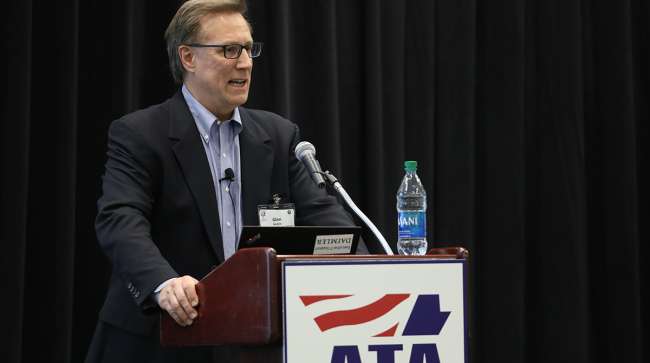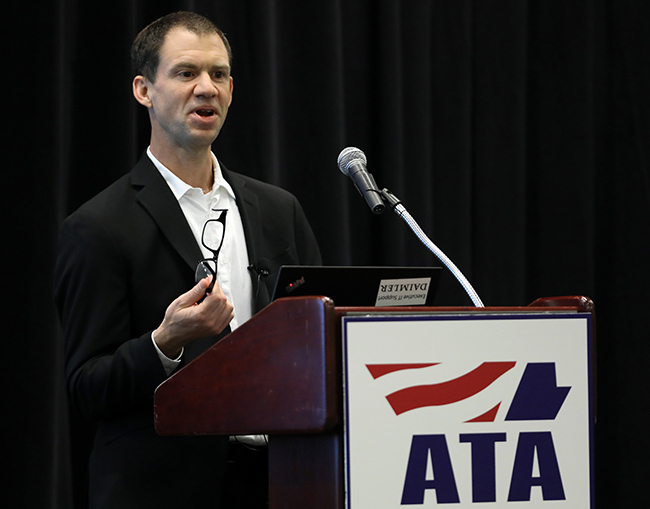Staff Reporter
Where Trucking Stands on Environmental Sustainability

[Stay on top of transportation news: Get TTNews in your inbox.]
NASHVILLE, Tenn. — Sustainability in the trucking industry can be viewed from different angles, according to a panel at American Trucking Associations’ Management Conference & Exhibition on Oct. 25.
“Lots of people look at sustainability through different lenses,” said Glen Kedzie, energy and environmental affairs counsel at ATA. “Some look at it as addressing climate change, reducing carbon emissions, others are more expansive in their view of it.”
Kedzie added that looking at sustainability through business functions is typically called environmental and social governance. He noted the trucking industry is facing a lot of pressure on that front. But it’s important to consider the entire supply chain.
“It’s not just from trucks,” Kedzie said. “You have to look at what happens coming up to the truck level and then after the truck level. The supply chain can be responsible for up to five times the greenhouse gas emissions than from just one singular source, from an individual company.”
Kedzie added that this is why environmental groups and investors are looking at the life cycle of carbon emissions from an operations perspective. But behind this, he noted, is a lot of driving factors; for example, 19% of NOx emissions in the U.S. come from trucking.
“Climate change is a major driver,” Kedzie said. “But there’s a lot of other drivers that are making leads as businesses consider sustainability. The public image is very important to all of us here in this room. Profitability can go hand-in-hand with sustainability. There are lots of legal considerations you have to take into account. There’s lots of litigation across the country.”
Kedzie added there are current and upcoming regulatory standards on both the federal and state level that companies need to be aware of. The U.S. Environmental Protection Agency, for instance, has been working on standards specific to trucks. These initiatives are further pushing trucks and fleets to be as close to zero-emission as possible.
“We have the EPA Phase 3 rule,” Kedzie said. “They will set the carbon metrics so low, without mentioning any technology path, that the only way that you’ll be able to achieve those standards will be to buy a battery-electric, hydrogen fuel cell or renewable diesel vehicle.”
Sean Waters, vice president of product compliance and regulatory affairs at Daimler Trucks North America, noted it’s also important to look at how much progress the industry has already made and how important trucking is.
“Heavy-duty trucks make life better,” Waters said. “Heavy-duty trucks save lives. And this industry has been an unquestioned partner working with the EPA, working with California, on tough but enforceable emissions regulations for decades. And that has led to cleaner air. It led to a reduction in CO2.”

“Trucks are the backbone of our economy,” Waters says. (John Sommers II for Transport Topics)
Waters added that sustainability can be a win for everyone when done right; for example, reducing fuel consumption can save companies on costs while reducing emissions. It’s also important, he noted, to realize a lot of NOx emissions are coming from pre-2010 trucks.
“Trucks are the backbone of our economy,” Waters said. “The trucks that we build are safer today, cleaner today, than they’ve ever been. And we need to start by recognizing the positive contributions we’ve made before we start talking about the next round of regulations and before we talk about trucks being the problem.”
Kedzie noted the current administration is very concerned about environmental justice and so people in the industry need to be aware and ready for that. But there is also pressure from within the industry, including customers and investors.
“Shippers want to become greener,” Kedzie said. “We have shareholders that are putting on pressure. They want to know where investments are being made. They want to see if those investments account for the use of green fuels and green technologies. We have Wall Street pushing back on us hard. We have lenders pushing back on us hard. We have the insurance industry pushing back on us hard.”
Craig Harper, chief sustainability officer at J.B. Hunt Transport Services, noted that it’s also important to realize current limitations and to be realistic. He pointed to the range of battery-electric trucks. While the technology is steadily improving, they still don’t have the range of many diesel trucks.
“We’re all excited about this whole energy transformation,” Harper said. “But you’ve got to be a realist about it. You walk out there on the floor and visit with the OEMs and you’ll see ranges of 110 miles. They talk about adding another battery and maybe getting up to 160 miles.”
Kedzie added that as the supply chain becomes more globalized there is an increasing focus on greening it up. He also noted the younger generations have different expectations and that has been pushing business trends in a more environmental direction.
“It’s not a passing fad,” Kedzie said. “You’re going to be playing in this space. If you aren’t playing in this space, you will have to play in this space because everyone is wanting fleets to be more accountable.”
Want more news? Listen to today's daily briefing below or go here for more info:


